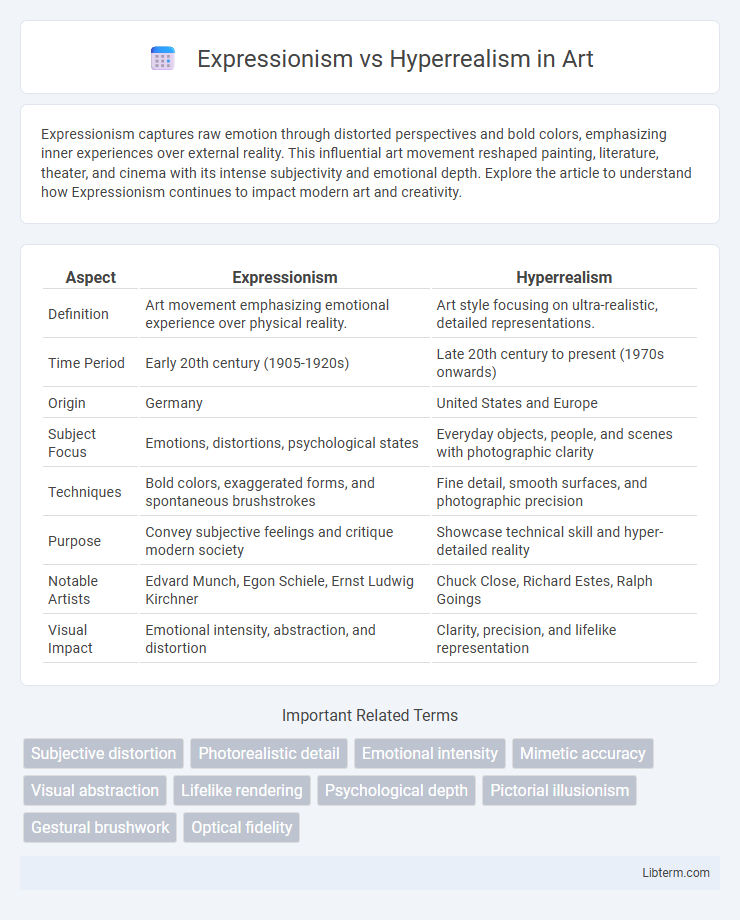Expressionism captures raw emotion through distorted perspectives and bold colors, emphasizing inner experiences over external reality. This influential art movement reshaped painting, literature, theater, and cinema with its intense subjectivity and emotional depth. Explore the article to understand how Expressionism continues to impact modern art and creativity.
Table of Comparison
| Aspect | Expressionism | Hyperrealism |
|---|---|---|
| Definition | Art movement emphasizing emotional experience over physical reality. | Art style focusing on ultra-realistic, detailed representations. |
| Time Period | Early 20th century (1905-1920s) | Late 20th century to present (1970s onwards) |
| Origin | Germany | United States and Europe |
| Subject Focus | Emotions, distortions, psychological states | Everyday objects, people, and scenes with photographic clarity |
| Techniques | Bold colors, exaggerated forms, and spontaneous brushstrokes | Fine detail, smooth surfaces, and photographic precision |
| Purpose | Convey subjective feelings and critique modern society | Showcase technical skill and hyper-detailed reality |
| Notable Artists | Edvard Munch, Egon Schiele, Ernst Ludwig Kirchner | Chuck Close, Richard Estes, Ralph Goings |
| Visual Impact | Emotional intensity, abstraction, and distortion | Clarity, precision, and lifelike representation |
Introduction to Expressionism and Hyperrealism
Expressionism emerged in the early 20th century as an art movement emphasizing emotional experience over physical reality, characterized by distorted forms and vivid colors to evoke subjective feelings. Hyperrealism, developing in the late 20th century, pushes visual accuracy to lifelike detail, often resembling high-resolution photographs to create an illusion of reality. Both movements respond differently to the human perception of reality, with Expressionism focusing on inner emotional truths and Hyperrealism on meticulous external representation.
Historical Origins and Evolution
Expressionism emerged in early 20th-century Germany as a reaction to industrialization and war, emphasizing emotional experience over physical reality. Hyperrealism developed in the late 1960s as an offshoot of photorealism, focusing on meticulous detail to create lifelike representations that often transcend photography. Both movements reflect distinct responses to cultural and technological changes, with Expressionism rooted in subjective distortion and Hyperrealism in objective replication.
Key Characteristics: Expressionism
Expressionism emphasizes emotional experience over physical reality, using distorted forms, bold colors, and dynamic brushstrokes to convey inner feelings and subjective perspectives. This movement often explores themes of anxiety, alienation, and human suffering, prioritizing psychological depth and intensity. Expressionist works reject naturalistic representation, instead highlighting emotional resonance and symbolic content to evoke powerful viewer responses.
Key Characteristics: Hyperrealism
Hyperrealism is characterized by meticulous attention to detail, aiming to create artworks that resemble high-resolution photographs with striking precision. Artists emphasize textures, light reflections, and minute imperfections to evoke an intense sense of reality that often transcends traditional photorealism. This movement prioritizes precision and polished techniques to achieve lifelike depictions that provoke emotional engagement through visual realism.
Influential Artists in Expressionism
Expressionism, a 20th-century art movement, was marked by artists like Edvard Munch, Egon Schiele, and Wassily Kandinsky, who conveyed intense emotional experiences through distorted forms and bold colors. These influential painters emphasized subjective perspectives and psychological depth over realistic depictions. In contrast, Hyperrealism, championed by artists such as Chuck Close and Richard Estes, focused on meticulous, highly detailed representations resembling high-resolution photographs.
Influential Artists in Hyperrealism
Hyperrealism, emerging in the early 2000s, is characterized by its precise, photographic detail, with influential artists such as Chuck Close, Audrey Flack, and Ron Mueck shaping the movement. These artists emphasize meticulous techniques to capture lifelike textures and expressions, often surpassing the clarity of traditional photography. Their work contrasts with Expressionism, which prioritizes emotional experience and subjective interpretation over realistic representation.
Techniques and Approaches Compared
Expressionism emphasizes emotional experience through bold, distorted forms and vivid colors, using techniques like impasto and dynamic brushstrokes to evoke subjective feelings. Hyperrealism adopts meticulous detailing and precise, camera-like clarity, employing airbrushing and layering to achieve lifelike textures and depth. While Expressionism prioritizes conveying inner emotions and abstraction, Hyperrealism focuses on replicating reality with extraordinary accuracy and subtle nuances.
Emotional Impact vs. Visual Precision
Expressionism emphasizes emotional impact through distorted forms and vivid colors that evoke subjective feelings, prioritizing the artist's inner experience over realistic representation. Hyperrealism focuses on visual precision, replicating intricate details with photographic accuracy to create lifelike images that captivate viewers through technical mastery. The contrast lies in Expressionism's goal to convey emotional depth, whereas Hyperrealism seeks to achieve meticulous realism.
Cultural and Artistic Significance
Expressionism revolutionized early 20th-century art by emphasizing emotional experience over physical reality, profoundly influencing modernist movements and reflecting societal anxieties during periods of upheaval. Hyperrealism emerged in the late 20th century, showcasing meticulous attention to detail and technical precision, challenging perceptions of reality and blurring the boundaries between photography and painting. Both movements contribute to cultural discourse by pushing artistic limits: Expressionism through subjective interpretation and social critique, Hyperrealism through visual accuracy and immersive representation.
Conclusion: Contrasts and Contemporary Relevance
Expressionism emphasizes emotional experience through distorted forms and vivid colors, while Hyperrealism focuses on meticulous detail and photographic accuracy to capture reality. Their contrasting approaches reveal diverse artistic intentions: subjective interpretation versus objective representation. Contemporary relevance lies in how both styles influence modern art, shaping cultural dialogues and expanding the boundaries of visual storytelling.
Expressionism Infographic

 libterm.com
libterm.com